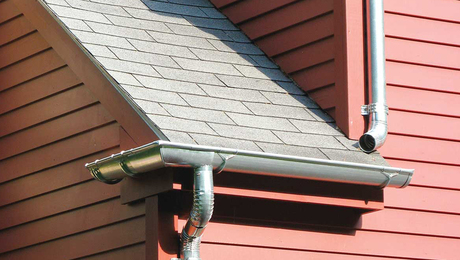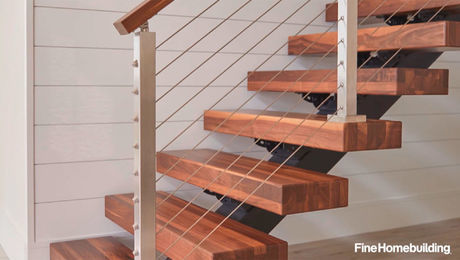Need HELP for 20’x30′ Garage Framing Plan.
Hello Everyone,
I seek help for a garage I’m designing to be built but I’m unsure if my framing layout is correct. Attached is a picture and PDF if you feel like marking it up with sticky notes..
Any advice and information is greatly appreciated.



















Replies
A few comments.
1. You can't frame a roof with a 30' span conventionally. You're never going to get by with 30 rafter ties/cieling joists. You should consider trusses.
2. A 4x12 header is too small for a 16' opening in a bearing wall. If you use trusses you can use a standard truss with fill over this wall and eliminate the roof loads on it.
3. You need king studs at the ends of headers.
4. You need to call out your footing sizes. You need to specify spacing of anchor bolts. You need reinforcing at your footings.
5. You don't need two fire blocks per stud bay. If you use sheathing you really don't need any with 9' studs. If you don't you need to block with one block, 3 bays next to corners and openings if you use stucco. You probably need some sheathing for shear.
6. You need to specify your roof covering and its weight.
Maybe improve blocking ?
Hi,
I built a 12' L x 8' w x 10' high shed. I found out to put in some blocking on angles, not all horizontal. A neighbor came over, saw my progress and said watch, as he leaned against a corner. The whole shed wobbled. Once we put in 3 blocks a few places, the whole side became stiffer. Simple to do, just two 45 deg cuts on each end. I also found out about a California wall. Use 2"x6" every 2 ft apart. instead of 2"x4" , 16" center to center. Save on wood costs. I'm thinking about using 2"x6" , 2' centers.
my 2 cents
Ditto what Mike said.
re-think monolithic slab
EXISTING FOUNDATION PLAN:
Looks like you have drawn a monolithic slab with a short stem wall. Looks great on paper, but a pain in the butt to pull off in the field (even for the best concrete sub). Also, you must introduce very specific reinforcment and control joints in your slab in order to control concrete cracking. In my experience the chances for nasty diagonal cracks is high with the way you have drawn it.
OPTION:
I would highly recommend seperating the slab from the footing. Pour your footings first. Next, form and pour your stem wall with a haunch to catch the slab . Finally, pour your interior slab (with perimter expansion joint) after you're under roof. In my opinoin, you increase the likelihood of a better performing and nicer looking interior slab this way.
Monolithic slab foundation
That type of foundation is very common in our area. Probably 99%. Sometime called a waffle slab.
Typical slab would be 12"wx24"d perimeter beam and smaller interior beams max. 16' O.C. with 4" thk. slab. Beam rebar, 2 #5 top and bot. with #3 18" OC. B.W. Also done with post stress engineered slabs. Our soils are bad. Are high clay content.
Quicker and cheaper than two pour. At least around here.
Just curious about your quick and cheaper techniques
oops-
Just curious how you all handle the stem wall form portion of your single pour. in other words, what type of form work are you using that you can strip after stem has set...and still have an opportunity to trowel your slab area against that wall before concrete sets too much?
Also, how are you handling the plastice shrinkage in the monoithic pour? Or are you figuring none? Concrete will always shrink to its geometric centroid. And In a monolitic pour that size you will definely get measurable shrinkage. I would think that could affect your framing depending on how fast the work is sequenced. I also believe it is a rather complex calculation to fiqure where to place your control joint (if they're used) for a monolithic waffle slab; particularly if there is not a cold/slip joint over any grade beam areas.
Monolithic slab foundation
Deadnuts. You would be surprised at the size of some of the pours for residential construction with no control joints. There is no wall to finish against. The top of the forms is the fin. slab ht.
Typical set up is the lot is graded flat/level, 2 x 12 forms set on grade with 2 x 6 set flush with top of form for brick ledge, plumbing roughed, beams are dug and the slab area is graded, poly installed and steel tied and 3000psi conc. poured and finished. A litle more forming is required for 4" garage stem etc. Done. Forms pulled next day and framing the next. Oh, I forgot the anchor bolts. :) If they are on fill, piers are placed under ithe beams, usually 12" dia. +/= 8' O.Cl
Most of the large projects builder use post stress systems, but is pretty much the same except for cables in lieu of rebar which could reduce the shrinkage consideration..
Seriously, thougy this is overly simplified but is common practice in these parts and has been for the 50+ years i've been in the bus.
oops wrote:
A litle more forming is required for 4" garage stem etc. Done.
A little? Actually there would be a fair amount of forming, stripping, and finishing to be done. Not any easy task in my opinion. You definitely glossed over this part of your explanation.
I agree that mononlithic slabs are straightforward. That's why most folks gravitate toward wanting to pour them. I'm sure folks have been doing it for 50 years or more. Most people take the easy route. That doesn't mean that it is the correct one.. or is the best solution. I've already pointed out one shortcoming of pouring mononlithic slabs. Another is that they don't work well when the site isn't flat. That is because flat, monlithic slab may not give you the code required seperation of 8" from framing to grade; particularly with sigficant grade changes. The result can not only be failed inspections, but water intrusion and rot. This is why stem walls are incorporated and perhaps why it is incorporated in the original posters drawing. Unlike finefinish, I see no reason to assume it is a mistake.
I still contend that, if a stem wall is required by code, then the best way to do it is to isolate it from the slab pour. Below is how we do it. If someone can explain a "quick and easy" way of pouring a stem and slab in one shot, I'd like to hear it.
If it's cheaper for you all to do a waffle slab, then that's great. However, the drawing section does not show the type of concrete pour you're describing.